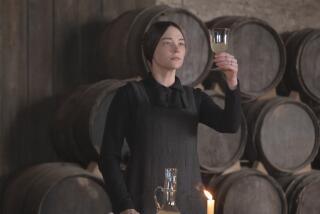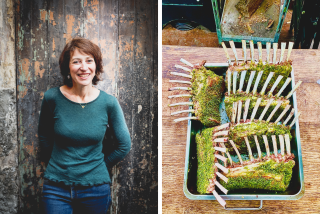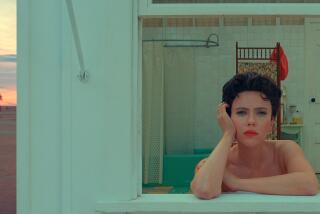THE LITTLE 10-FRANC COIN THAT COULDN’T
PARIS — The most startling opening of a news story that I have seen in many years of reading French papers could be found the other day on the financial page of Le Matin.
“The French don’t like money,” it said. Eyes popping, I read further, only to learn something I already knew--it isn’t money itself that the French have taken against but the horrid new 10-franc coins that people are handing about like hot potatoes in hopes of unloading them.
The problem is that the new 10-franc piece (worth about $1.50) is almost indistinguishable from the smaller 50-centime piece, which is worth only 8 cents. The new coin is decorated with a Gallic rooster, but it has given the mint little to crow about.
It seems that the larger and heavier old 10-franc coin was easy to counterfeit and, being copper-based, difficult for automatic vending machines to digest. The new coin is nickel-based and, from the fuss, there have been as many objections as there are new coins in circulation--120 million, to be precise.
The mint has had several fiascoes in recent years. In 1982 and again in 1986, it tried to get people to use 100-franc coins instead of bank notes and failed, with the result that nearly 19 million unused 100-franc coins are rusting in its coffers. Then there was the 1980 50-franc coin, which was too successful: People kept it rather than spent it because it was handsome and because the value of its metal content soon exceeded its face value.
The new 10-franc coin shows the mint’s innocence where basic psychology is concerned: It is never a good idea to replace a coin with a smaller version because people get the feeling that the value of their money is shrinking. Add this to the easy confusion with a coin of much lesser value and you have the makings of a mini-revolt. Having introduced the new coin at a press conference in October, Finance Minister Edouard Balladur has apparently had second thoughts: He has announced that distribution of the new 10-franc coins will be halted pending an investigation. The new coin costs only 1 franc to produce but it may well turn out to be France’s costliest coin.
On the subject of startling news stories, my favorite was one of some 10 years ago, when it was reported that a woman had committed suicide by a particularly dreadful method: She had drunk an excess of water and had drowned.
The reporter wisely did not attempt to clarify the details but the implications were clear: Water drinking was a dangerous and even deadly habit.
But that was 10 years ago, and France has changed. Wine consumption has dropped, sales of fruit juice and mineral water have soared. Now the inevitable has happened: A bar that serves nothing but bottled water has opened in the posh Passy section of Paris.
Everyone knows that France has more than 400 cheeses but few were aware, until Philippe Gangloff opened his Bar Nicolo, that this rich country also has more than 200 mineral springs. There are not only the grand crus that have become household names, such as Perrier and Evian, but small regional tipples such as Ondine Ardechoise from the center of France and Eperviere du Maine-et-Loire.
Connoisseurs discuss the delicate sulfuric aroma of the one, the delicate bicarbonate aftertaste of another, the quantity of natural bubble in a third. Included on the bar’s water list are bottles from Scotland, Morocco, Switzerland, Italy (the Aqua della Madonna is especially recommended).
Gangloff sells his waters for about 75 cents a glass. A lot of money for a naive domestic water, perhaps, but you may be amused by its lack of pretense.
Jumping on the water wagon, the Pompidou Museum is currently featuring an exhibition of plastic mineral water bottles--specifically, bottles designed for the well-known brand Vittel. Not the most flavorful of waters, Vittel has nonetheless been one of the most go-ahead producers since its springs were discovered in 1854. In 1968, Vittel was the first to use plastic bottles; in 1974, the first to use rectangular plastic bottles. Now they have asked designers from France, Britain, the United States and Brazil to design a bottle for the year 2000.
The results range from the dented plastic of the inappropriately named James Wines of the United States to a bottle clearly descended from post-modern architecture by Peter Cook of Great Britain. Eduardo Barroso-Neto of Brazil used a computer to help design his square container with a hole in the middle, into which a cooling element can be introduced.
French designer Christian Ragot went beyond the concept of the bottle. He pours his Vittel into a short plastic cape with a tube leading to the mouth for the occasional sip. His idea, he explains, is “to demystify a synthetic product in order to give it sensual power and to make it an object of desire.”
The most eagerly awaited event of the Paris theater season has turned out to be as exciting as a glass of tepid Vittel. It is hard to know what went wrong with Giorgio Strehler’s version of “The Threepenny Opera,” which opened at the Chatelet Theater with an international cast led by the otherwise excellent German film actress Barbara Sukowa as Polly Peacham. Strehler, an Italian who has headed France’s Theatre de l’europe since 1982, is one of the most respected directors around and he has had long experience with “Threepenny Opera,” starting at the Piccolo Teatro in Milan in 1956 when he first directed it under the supervision of Bertolt Brecht himself. The current production is Strehler’s third and it feels as long and cumbersome as Wagner, with none of the sourness and grit of the Brecht-Weill original. The four-hour-long evening somehow diminishes the piece, leaving it as shrunken and meaningless as, say, a new 10-franc coin.
More to Read
Sign up for Essential California
The most important California stories and recommendations in your inbox every morning.
You may occasionally receive promotional content from the Los Angeles Times.










